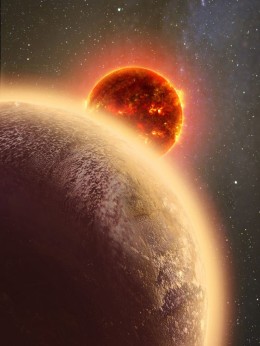Next week we’ll be reporting from the joint 48th meeting of the Division for Planetary Sciences (DPS) and 11th European Planetary Science Congress (EPSC). Planetary science articles are a large component of the work featured in AAS journals; nearly 400 planetary science articles were published in AAS journals in 2015 alone, and these have already gathered almost 2400 citations.
In the lead-up to next week’s meeting, we’d like to introduce Melissa McGrath, our new Lead Editor for the Solar System, Exoplanets, and Astrobiology corridor. Melissa is a Senior Scientist at the SETI Institute. Her impressive list of former positions includes Deputy Director of NASA’s Science Mission Directorate’s Planetary Science Division, and Chair of the AAS’s Division for Planetary Sciences.
* * * * *

Artist’s impression of the planned Jupiter Icy moons Explorer (JUICE) mission that will study Ganymede, Callisto, and Europa. [NASA/JPL]
I’ve worked on a wide variety of things, primarily planet and satellites atmospheres, particularly the Galilean satellites of Jupiter. I’m currently involved in several Hubble Space Telescope observing programs, and I’m also a co-investigator on three instruments flying on missions to Europa and Ganymede.
What is your history with the AAS Journals?
I started out as a Scientific Editor for AJ in 2009 handling the solar system papers. I then was added to both ApJ Letters and ApJ as a Scientific Editor. Now I am one of the six Lead Editors for AAS Journals (ApJ + AJ), handling solar system, exoplanets, and astrobiology papers.
What do you anticipate will be some of the most exciting topics presented on at the DPS/EPSC meeting next week?
Planet Nine, results from the New Horizons mission to Pluto, the first results from the Juno mission, and the latest work on exoplanets, to name just a few!
What do you consider to be some of the biggest open questions in the field of planetary science today?
Is there life beyond Earth in the solar system? How did our own solar system form?
Your journal corridor, “Solar System, Exoplanets, and Astrobiology”, encompasses a broad range of topics. How do you feel that these different areas of research all fit together?They are tied closely together by the search for life beyond Earth, by understanding how planetary systems form and evolve. They are also tied closely together by the study of planetary atmospheres, both within our own solar system and in exoplanets.
What do you think makes for a well-authored paper?
The most fundamental thing is having a new result and explaining it in a clear, concise, and convincing fashion.
Is there anything else you’d like to share about the publishing process with potential authors?
I’m continually impressed with how professional the whole process of peer review and publishing of new science results is. Both the authors and referees do an outstanding job, and almost without exception they are both geared to making high-quality science research available to the community in a positive, success-oriented process. That makes being an Editor a fun job for the most part.
* * * * *
Look for the AAS Publishing team at DPS 48/EPSC 11 next week — we’ll be in the exhibit hall at Booth #101! And if you can’t be at the meeting, be sure to check back on this site all next week, as AAS Nova and Astrobites will be working together to bring you daily updates from the meeting.


